Environmental Chemistry - Air pollution | 11th Chemistry : UNIT 15 : Environmental Chemistry
Chapter: 11th Chemistry : UNIT 15 : Environmental Chemistry
Air pollution
Air
pollution
Any
undesirable change in air which adversely affects living organisms is called
air pollution. Air pollution is limited to troposphere and stratosphere. Air
pollution is mainly due to the excessive discharge of undesirable foreign
matter in to the atmospheric air.
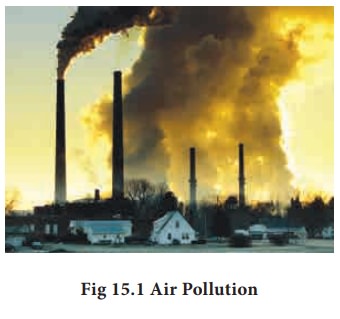
Types of air pollutants
Air
pollutants may exist in two major forms namely, gases and particulates.
1. Gaseous air pollutants
Oxides
of sulphur, oxides of nitrogen, oxides of carbon, and hydrocarbons are the
gaseous air pollutants.
a. Oxides of Sulphur
Sulphur
dioxide and sulphur trioxide are produced by burning sulphur containing fossil
fuels and roasting sulphide ores. Sulphur dioxide is a poisonous gas to both
animals and plants. Sulphur dioxide causes eye irritation, coughing and
respiratory diseases like asthma, bronchitis,etc.
Sulphur
dioxide is oxidised into more harmful sulphur trioxide in the presence of
particulate matter present in polluted air .

SO3
combines with atmospheric water vapour to form H2SO4 ,
which comes down in the form of acid rain.
SO3
+ H2O → H2SO4
![]()
![]() Some harmful effects of acid rain will be discussed in
section 15.3
Some harmful effects of acid rain will be discussed in
section 15.3
b. Oxides of nitrogen
Oxides
of nitrogen are produced during high temperature combustion processes,
oxidation of nitrogen in air and from the combustion of fuels (coal, diesel,
petrol etc.).
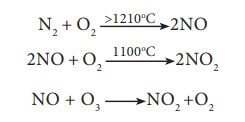
The
oxides of nitrogen are converted into nitric acid which comes down in the form
of acid rain. They also form reddish brown haze in heavy traffic. Nitrogen
dioxide potentially damages plant leaves and retards photosynthesis. NO 2
is a respiratory irritant and it can cause asthma and lung injury. Nitrogen
dioxide is also harmful to various textile fibres and metals.
c. Oxides of carbon
The
major pollutants of oxides of carbon are carbon monoxide and carbon dioxide.
(i) Carbon Monoxide
Carbon
monoxide is a poisonous gas produced as a result of incomplete combustion of
coal are firewood. It is released into the air mainly by automobile exhaust. It
binds with haemoglobin and form carboxy haemoglobin which impairs normal oxygen
transport by blood and hence the oxygen carrying capacity of blood is reduced.
This oxygen deficiency results in headache, dizziness, tension, Loss of
consciousness, blurring of eye sight and cardiac arrest.
(ii) Carbon dioxide
Carbon
dioxide is released into the atmosphere mainly by the process of respiration,
burning of fossil fuels, forest fire, decomposition of limestone in cement
industry etc.
Green
plants can convert CO2 gas in the atmosphere into carbohydrate and
oxygen through a process called photosynthesis. The increased CO 2
level in the atmosphere is responsible for global warming. It causes headache
and nausea.
(d) Hydrocarbon
The
compounds composed of carbon and hydrogen only are called hydrocarbons. They
are mainly produced naturally (marsh gas) and also by incomplete combustion of
automobile fuel.
They
are potential cancer causing (carcinogenic) agents. For example, polynuclear
aromatic hydrocarbons (PAH) are carcinogenic, they cause irritation in eyes and
mucous membranes.
2. Greenhouse effect and Global warming:
In
1987, Jean Baptiste Fourier a
French mathematician and
scientist coined the term“Greenhouse Effect” for trapping of heat in the
atmosphere by certain gases.
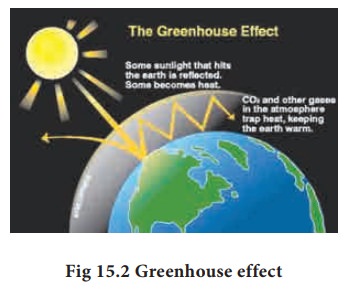
The
earth’s atmosphere allows most of the visible light from the Sun to pass
through and reach Earth’s surface. As Earth’s surface is heated by sunlight, it
radiates part of this energy back toward space as longer wavelengths (IR).
Some
of the heat is trapped by CH4, CO2, CFCs and water vapour
present in the atmosphere. They absorb IR radiation and effectively block a
large portion of earth’s emitted radiation. The radiation thus absorbed is
partly reemitted to earth’s surface. Therefore, the earth’s surface gets heated
up by a phenomenon called greenhouse effect.
Thus
Greenhouse effect may be defined as the heating up of the earth surface due to
trapping of infrared radiations reflected by earth’s surface by CO2
layer in the atmosphere”. The heating up of earth through the greenhouse effect
is called global warming.
Without
the heating caused by the greenhouse effect, Earth’s average surface temperature would
be only about −18 °C (0 °F). Although the greenhouse effect is a naturally
occurring phenomenon, it is intensified by the continuous emission of
greenhouse gases into the atmosphere.
During
the past 100 years, the amount of carbon dioxide in the atmosphere increased by
roughly 30 percent and the amount of methane more than doubled.If these trends
continue, the average global temperature will increase which can lead to
melting of polar ice caps and flooding of low lying areas. This will increase
incidence of infectious diseases like dengue, malaria etc.
3. Acid Rain
Rain
water normally has a pH of 5.6 due to dissolution of atmospheric CO2
into it. Oxides of sulphur and nitrogen in the atmosphere may be absorbed by
droplets of water that make up clouds and get chemically converted into
sulphuric acid and nitric acid respectively as a results of pH of rain water
drops to the level 5.6, hence it is called acid rain.
Acid
rain is a by-product of a variety of sulphur and nitrogen oxides in the
atmosphere. Burning of fossil fuels (coal and oil) in power stations, furnaces
and petrol, diesel in motor engines produce sulphur dioxide and nitrogen oxides.
The main contributors of acid rain are SO2 and NO2 .They
are converted into sulphuric acid and nitric acid respectively by the reaction
with oxygen and water.
2SO2
+ O2 + 2H2O → 2H2SO4
4NO2
+ O2 + 2H2O→ 4HNO3
Harmful effects of acid rain:
Some harmful effects are discussed
below.
i.
Acid rain causes extensive damage to buildings and structural materials of
marbles. This attack on marble is termed as Stone leprosy.
CaCO3
+ H2SO4→ CaSO4 + H2O
+CO2↑
ii.
Acid rain affects plants and animal life in aquatic ecosystem.
iii.
It is harmful for agriculture, trees and plants as it dissolves and removes the
nutrients needed for their growth.
iv.
It corrodes water pipes resulting in the leaching of heavy metals such as iron,
lead and copper into the drinking water which have toxic effects.
v.
It causes respiratory ailment in humans and animals.
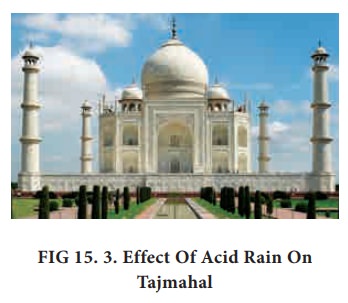
B. Particulate matter (Particulate pollutants)
Particulate
pollutants are small solid particles and liquid droplets suspended in air. Many
of particulate pollutants are hazardous. Examples: dust, pollen, smoke, soot
and liquid droplets (aerosols) etc,.
They
are blown into the atmosphere by volcanic eruption, blowing of dust, incomplete
combustion of fossil fuels induces soot. Combustion of high ash fossil fuels
creates fly ash and finishing of metals throws metallic particles into the
atmosphere.
1. Types of Particulates:
Particulate
in the atmosphere may be of two types, viable or non-viable.
a. Viable particulates
The
viable particulates are the small size living organisms such as bacteria,
fungi, moulds, algae, etc. which are dispersed in air. Some of the fungi cause
allergy in human beings and diseases in plants.
b. Non-viable particulates
The
non- viable particulates are small solid particles and liquid droplets
suspended in air. They help in the transportation of viable particles. There
are four types of non-viable particulates in the atmosphere. They are
classified according to their nature and size as follows
(i) Smoke
Smoke
particulate consists of solid particles (or) mixture of solid and liquid
particles formed by combustion of organic matter.
For
example, cigarette smoke, oil smoke, smokes from burning of fossil fuel,
garbage and dry leaves.
(ii) Dust:
Dust
composed of fine solid particles produced during crushing and grinding of solid
materials.
For
example, sand from sand blasting, saw dust from wood works, cement dust from
cement factories and fly ash from power generating units.
(iii) Mists
They
are formed by particles of spray liquids and condensation of vapours in air.
For
example, sulphuric acid mist, herbicides and insecticides sprays can form
mists.
(iv) Fumes
Fumes
are obtained by condensation of vapours released during sublimation,
distillation, boiling and calcination and by several other chemical reactions.
For
example, organic solvents, metals and metallic oxides form fume particles.
2. Health effects of particulate pollutants:
i.
Dust, mist, fumes,etc., are air borne particles which are dangerous for human health. Particulate
pollutants bigger than 5 microns are likely to settle in the nasal passage
whereas particles of about 10 micron enters the lungs easily and causes scaring
or fibrosis of lung lining. They irritate the lungs and causes cancer and
asthma. This disease is also called pneumoconiosis. Coal miners may suffer from
black lung disease. Textile workers may suffer from white lung disease.
ii.
Lead particulates affect children’s brain, interferes maturation of RBCs and
even cause cancer.
iii.
Particulates in the atmosphere reduce visibility by scattering and absorption
of sunlight. It is dangerous for aircraft and motor vehicles
iv.
Particulates provide nuclei for cloud formation and increase fog and rain.
v.
Particulates deposit on plant leaves and hinder the intake of CO2
from the air and affect photosynthesis.
3. Techniques to reduce particulate pollutants
The
particulates from air can be removed by using electrostatic precipitators,
gravity settling chambers, and wet scrubbers or by cyclone collectors. These
techniques are based on washing away or settling of the particulates.
C. Smog
Smog
is a combination of smoke and fog which forms droplets that remain suspended in
the air.
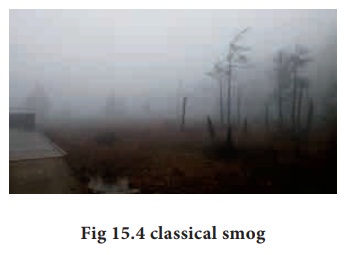
Smog
is a chemical mixture of gases that forms a brownish yellow haze over urban
cities.Smog mainly consists of ground level ozone, oxides of nitrogen, volatile
organic compounds, SO2, acidic aerosols and gases, and particulate
matter.
There
are two types of smog. One is Classical smog caused by coal smoke and fog ,
second one is photo chemical smog caused by photo chemical oxidants.They are
discussed below in detail.
(i) Classical smog or London smog
Classical
smog was first observed in London in December 1952 and hence it is also known
as London smog. It consists of coal smoke and fog.
It
occurs in cool humid climate. This atmospheric smog found in many large cities.
The chemical composition is the mixture of SO2, SO3 and
humidity. It generally occurs in the morning and becomes worse when the sun
rises.
This
is mainly due to the induced oxidation of SO2 to SO3,
which reacts with water yielding sulphuric acid aerosol.
Chemically
it is reducing in nature because of high concentration of SO2 and so
it is also called as reducing smog.
Effects of classical smog:
a.
Smog is primarily responsible for acid rain.
b.
Smog results in poor visibility and it affects air and road transport.
c.
It also causes bronchial irritation.
ii)Photo chemical smog or Los Angel Smog
Photo
Chemical smog was first observed in Los Angels in 1950. It occurs in warm, dry
and sunny climate.This type of smog is formed by the combination of smoke, dust
and fog with air pollutants like oxides of nitrogen and hydrocarbons in the
presence of sunlight.
It
forms when the sun shines and becomes worse in the afternoon. Chemically it is
oxidizing in nature because of high concentration of oxidizing agents NO2
and O3, so it is also called as oxidizing smog.
Photo chemical smog is formed through sequence of following reactions.
N2
+ O2 →2NO
2NO
+ O2 → 2NO2

(O)+O2
→O3
O3+NO → NO2 + O2
NO
and O3 are strong oxidizing agent and can react with unburnt
hydrocarbons in polluted air to form formaldehyde,acrolein and peroxy acetyl
nitrate(PAN).
Effects of photo chemical smog
The
three main components of photo chemical smog are nitrogen oxide, ozone and
oxidised hydro carbon like formaldehyde(HCHO), Acrolein (CH2=CH-CHO),peroxy
acetyl nitrate (PAN).
Photochemical smog causes irritation to eyes, skin and lungs, increase in chances of asthma.
High concentrations of ozone and NO can cause nose and
throat irritation, chest pain, uncomfortable in breathing, etc.
PAN
is toxic to plants, attacks younger leaves and cause bronzing and glazing of
their surfaces
It
causes corrosion of metals stones, building materials and painted surfaces.
Control of Photo chemical smog
The
formation of photochemical smog can be suppressed by preventing the release of
nitrogen oxides and hydrocarbons into the atmosphere from the motor vehicles by
using catalytic convertors in engines. Plantation of certain trees like Pinus,
Pyrus, Querus Vitus and juniparus can metabolise nitrogen oxide.
Related Topics